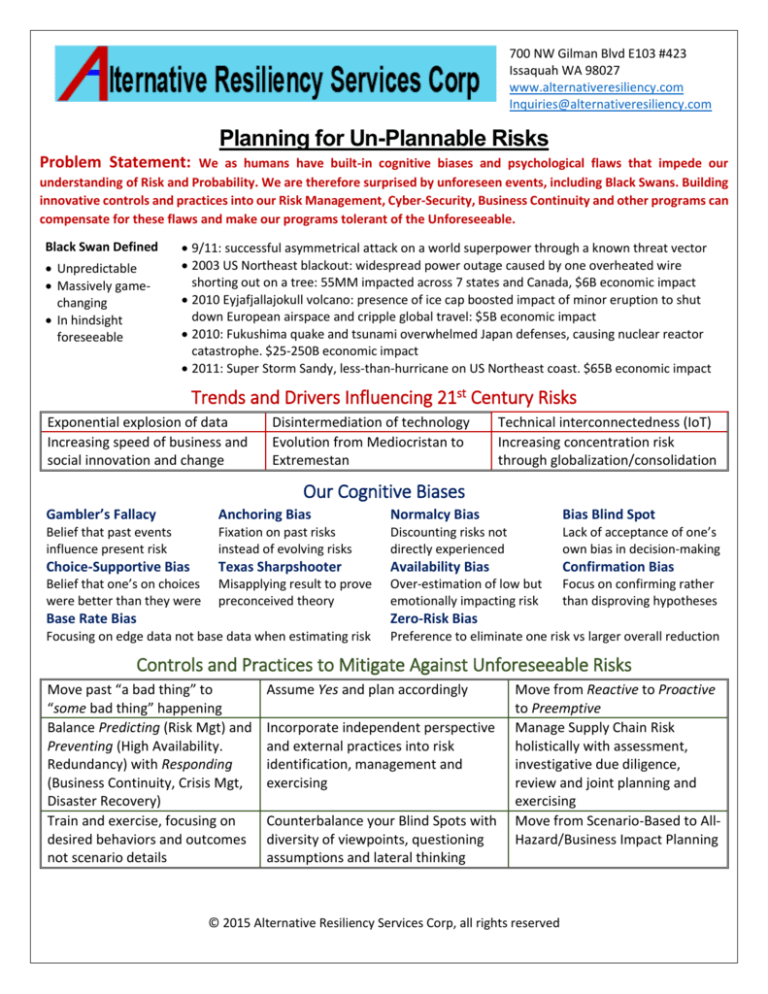
700 NW Gilman Blvd E103 #423
Issaquah WA 98027
www.alternativeresiliency.com
Inquiries@alternativeresiliency.com
Planning for Un-Plannable Risks
Problem Statement:
We as humans have built-in cognitive biases and psychological flaws that impede our
understanding of Risk and Probability. We are therefore surprised by unforeseen events, including Black Swans. Building
innovative controls and practices into our Risk Management, Cyber-Security, Business Continuity and other programs can
compensate for these flaws and make our programs tolerant of the Unforeseeable.
Black Swan Defined
Unpredictable
Massively gamechanging
In hindsight
foreseeable
9/11: successful asymmetrical attack on a world superpower through a known threat vector
2003 US Northeast blackout: widespread power outage caused by one overheated wire
shorting out on a tree: 55MM impacted across 7 states and Canada, $6B economic impact
2010 Eyjafjallajokull volcano: presence of ice cap boosted impact of minor eruption to shut
down European airspace and cripple global travel: $5B economic impact
2010: Fukushima quake and tsunami overwhelmed Japan defenses, causing nuclear reactor
catastrophe. $25-250B economic impact
2011: Super Storm Sandy, less-than-hurricane on US Northeast coast. $65B economic impact
Trends and Drivers Influencing 21st Century Risks
Exponential explosion of data
Increasing speed of business and
social innovation and change
Disintermediation of technology
Evolution from Mediocristan to
Extremestan
Technical interconnectedness (IoT)
Increasing concentration risk
through globalization/consolidation
Our Cognitive Biases
Gambler’s Fallacy
Anchoring Bias
Normalcy Bias
Bias Blind Spot
Belief that past events
influence present risk
Fixation on past risks
instead of evolving risks
Discounting risks not
directly experienced
Lack of acceptance of one’s
own bias in decision-making
Choice-Supportive Bias
Texas Sharpshooter
Availability Bias
Confirmation Bias
Belief that one’s on choices
were better than they were
Misapplying result to prove
preconceived theory
Over-estimation of low but
emotionally impacting risk
Focus on confirming rather
than disproving hypotheses
Base Rate Bias
Zero-Risk Bias
Focusing on edge data not base data when estimating risk
Preference to eliminate one risk vs larger overall reduction
Controls and Practices to Mitigate Against Unforeseeable Risks
Move past “a bad thing” to
“some bad thing” happening
Balance Predicting (Risk Mgt) and
Preventing (High Availability.
Redundancy) with Responding
(Business Continuity, Crisis Mgt,
Disaster Recovery)
Train and exercise, focusing on
desired behaviors and outcomes
not scenario details
Assume Yes and plan accordingly
Incorporate independent perspective
and external practices into risk
identification, management and
exercising
Counterbalance your Blind Spots with
diversity of viewpoints, questioning
assumptions and lateral thinking
Move from Reactive to Proactive
to Preemptive
Manage Supply Chain Risk
holistically with assessment,
investigative due diligence,
review and joint planning and
exercising
Move from Scenario-Based to AllHazard/Business Impact Planning
© 2015 Alternative Resiliency Services Corp, all rights reserved







